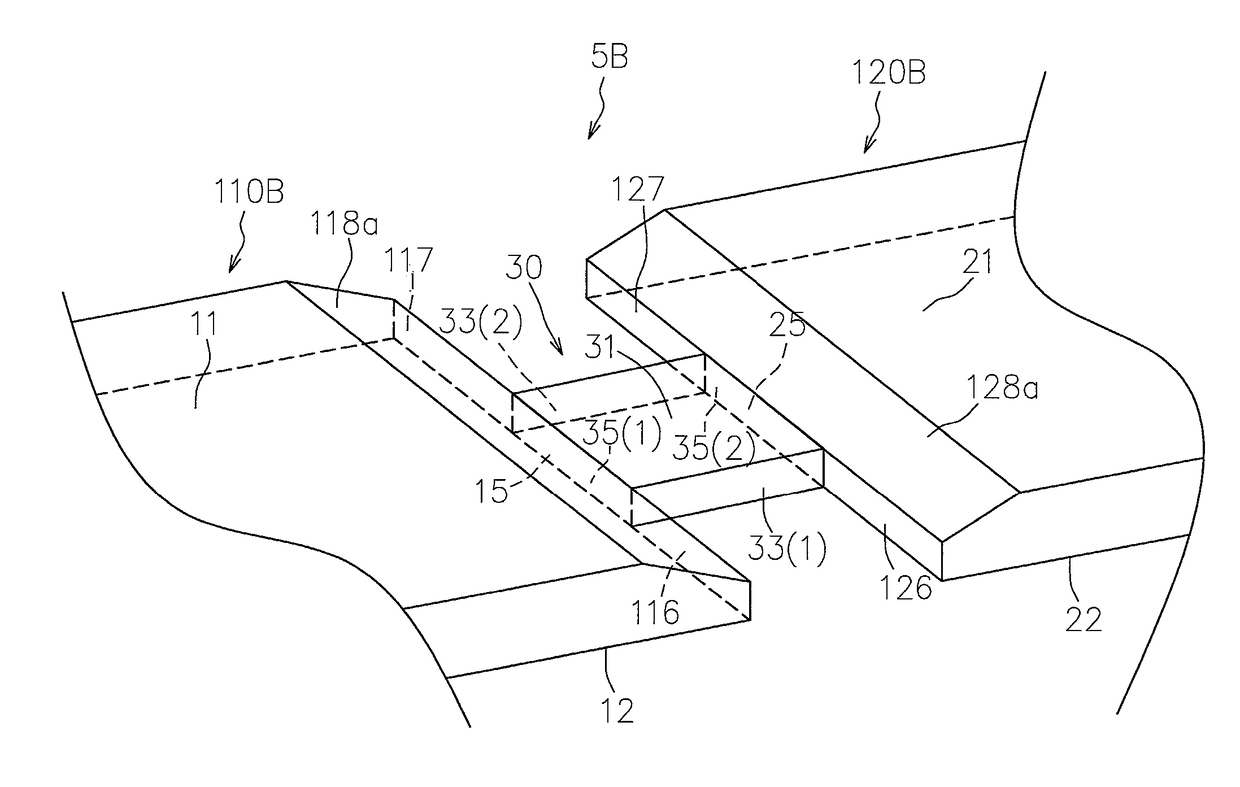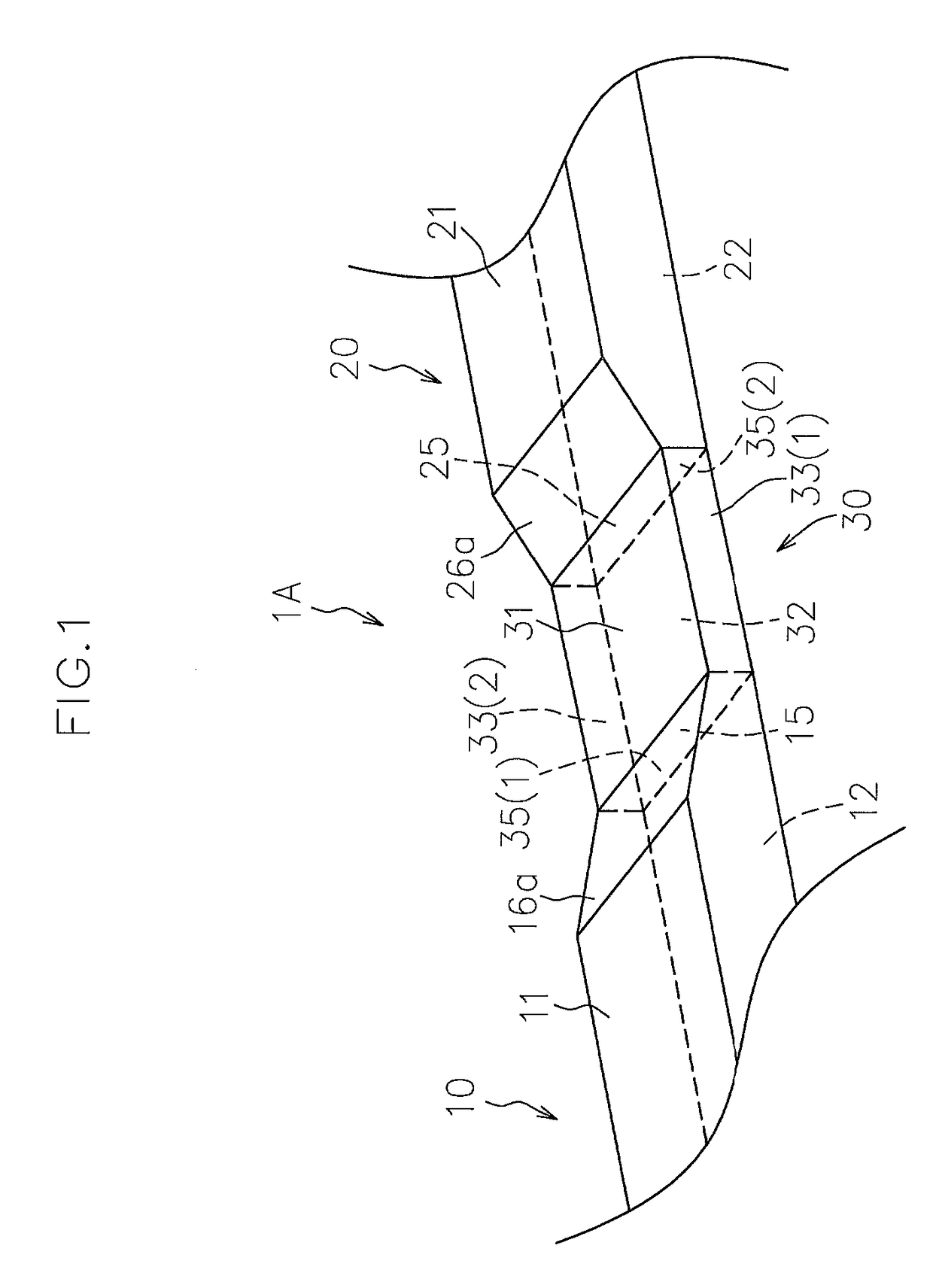Method for manufacturing shunt resistor
- Summary
- Abstract
- Description
- Claims
- Application Information
AI Technical Summary
Benefits of technology
Problems solved by technology
Method used
Image
Examples
embodiment 1
[0041]Hereinafter, one embodiment of a method for manufacturing a shunt resistor according to the present invention is described with reference to the accompanying drawings.
[0042]FIG. 1 illustrates a perspective view of a shunt resistor 1A manufactured by the manufacturing method according to this embodiment.
[0043]FIGS. 2A and 2B illustrate a side view and an exploded side view, respectively, of the shunt resistor 1A.
[0044]As illustrated in FIG. 1, FIG. 2A, and FIG. 2B, the shunt resistor 1A has a resistance alloy plate member 30 and first and second conductors 10, 20 which are respectively joined to one side and the other side in the current flow direction of the resistance alloy plate member 30.
[0045]The first and second conductors 10, 20 are formed of a conductive member and, for example, a Cu metal plate member is preferably used.
[0046]The first and second conductors 10, 20 are provided with a pair of detection terminals (not illustrated) that are located near the resistance all...
embodiment 2
[0080]Hereinafter, another embodiment of the method for manufacturing a shunt resistor according to the present invention is described with reference to the accompanying drawings.
[0081]FIGS. 4A and 4B illustrate a side view and an exploded side view, respectively, of a shunt resistor 2A manufactured by the manufacturing method according to this embodiment.
[0082]In the figures, the same members as those in Embodiment 1 are designated by the same reference numerals and a description thereof is omitted as appropriate.
[0083]The shunt resistor 2A of this embodiment has first and second conductors 50, 60 in place of the first and second conductors 10, 20 as compared with the shunt resistor 1A of Embodiment 1.
[0084]The plate thickness of at least either one of the first and second conductors 50, 60 is set larger than the plate thickness of the resistance alloy plate member 30 as with Embodiment 1.
[0085]In the embodiment illustrated in the figures, the plate thickness of both the first and ...
embodiment 3
[0094]Hereinafter, still another embodiment of the method for manufacturing a shunt resistor according to the present invention is described with reference to the accompanying drawings.
[0095]FIGS. 6A and 6B illustrate a side view and an exploded side view, respectively, of a shunt resistor 3A manufactured by the manufacturing method according to this embodiment.
[0096]In the figures, the same members as those in Embodiments 1 and 2 are designated by the same reference numerals and a description thereof is omitted as appropriate.
[0097]The shunt resistor 3A has a resistance alloy plate member 90 and first and second conductors 70, 80 which are respectively joined to one side and the other side in the current flow direction of the resistance alloy plate member 90.
[0098]The plate thickness of at least either one of the first and second conductors 70, 80 is set larger than the plate thickness of the resistance alloy plate member 90 as with Embodiments 1 and 2.
[0099]In the embodiment illus...
PUM
| Property | Measurement | Unit |
|---|---|---|
| Thickness | aaaaa | aaaaa |
| Electrical resistance | aaaaa | aaaaa |
Abstract
Description
Claims
Application Information
 Login to View More
Login to View More - R&D
- Intellectual Property
- Life Sciences
- Materials
- Tech Scout
- Unparalleled Data Quality
- Higher Quality Content
- 60% Fewer Hallucinations
Browse by: Latest US Patents, China's latest patents, Technical Efficacy Thesaurus, Application Domain, Technology Topic, Popular Technical Reports.
© 2025 PatSnap. All rights reserved.Legal|Privacy policy|Modern Slavery Act Transparency Statement|Sitemap|About US| Contact US: help@patsnap.com



